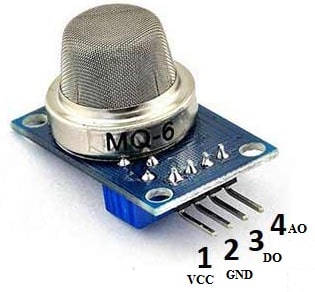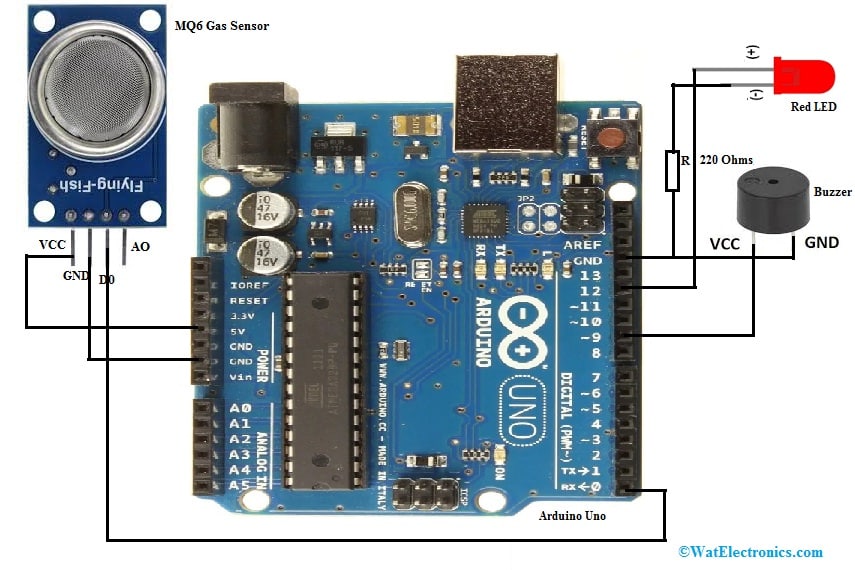Gas leakage detection in residences, work areas, and industries is a very crucial task because we don’t know the type of gas in the atmosphere and they can harm the surroundings and also human’s health. So MQ gas sensor is used to detect gas leakage but there are different kinds of gas sensors based on the type of gas leakage like MQ2, MQ3, MQ4, MQ5, MQ6, MQ7, MQ8, MQ9, and many more. The types of gases are; methane, smoke, alcohol, hydrogen, LPG, benzene, propane, NH3, etc. So this article discusses an overview of the MQ6 gas sensor, it’s working, and its applications.
What is MQ6 Gas Sensor?
A sensor that is used to detect Butane, LPG, and Propane gases in the air either in industry or at home is known as the MQ6 Gas sensor. This sensor can also be used for detecting different combustible gas, particularly Methane, so it is appropriate for different applications. This type of MQ sensor mainly includes a sensing element that is enclosed within a stainless-steel mesh that is ceramic based on aluminum-oxide and is covered with Tin dioxide.
The working of the MQ6 gas sensor is, whenever the gas in the air approaches the sensing element in the sensor, the sensing element’s resistivity will be changed. After that, this change is measured to obtain the gas concentration present in it. The sensing range of this sensor is very appropriate for gas leak detection within homes & different places like restaurants, and hotels wherever cooking is done with LPG cylinders. LPG combustion is extremely exothermal which means it releases a huge amount of heat once ignited, so using it in a controlled way is very helpful.
Pin Configuration:
The pin configuration of the MQ6 gas sensor is shown below. This gas sensor includes four pins which are discussed below.

MQ6 Gas Sensor Pin Configuration
- Pin1 (Vcc): This pin is used to provide +5V voltage to the gas sensor module.
- Pin2 (GND): This pin is used for connecting the gas sensor module to GND.
- Pin3 (Digital Out): This pin is used to obtain digital o/p by simply setting a threshold value with the potentiometer
- Pin4 (Analog Out): This pin outputs analog voltage from 0 to 5V depending on the gas intensity.
Other Pins
The other pins of the MQ6 gas sensor mainly include A-pins, B-pins, and H-pins which are discussed below.
- Pin1 (H –Pins): This sensor includes two H-pins where one H-pin is connected to the voltage supply whereas another pin is connected to GND.
- Pin2 (A-Pins): The A-pins & B-pins are the same, so these will be connected to the voltage supply.
- Pin3 (B-Pins): Both the A-pins & B-pins are identical where one pin acts as an o/p and another pin will be pulled to GND.
Features & Specifications:
The features & specifications of the MQ6 gas sensor include the following.
- This sensor can be used as an analog or digital sensor.
- This sensor’s digital pin sensitivity can be changed with the potentiometer.
- It has good sensitivity to combustible gas in the extensive range.
- These sensors detect LPG, Isobutane, and Propane.
- These sensors are low cost and they have a long life.
- It has a simple drive circuit.
- Its range of sensing concentration ranges from 300 to 10000ppm.
- Its voltage supply is <24V.
- Its heater voltage is 5.0V ± 0.2V.
- It has adjustable load resistance.
- Its heater resistance is 31Ω ± 3Ω.
- Heater utilization is <900mW.
- Its operating voltage is +5Volts.
- Its analog o/p voltage ranges from 0V – 5V.
- Its digital o/p voltage ranges from 0V or 5V.
- Its preheat duration is 20 secs.
Equivalent & Alternative MQ6 Gas Sensors
The equivalent MQ6 gas sensors are; AQ-2, MQ-2, MQ-306A, MQ-5, AQ-3and alternative MQ6 gas sensors are MQ-2, MQ-3, MQ-4, MQ-5, MQ-6, MQ-7, MQ-8, MQ-9, MQ131, MQ135, MQ136, MQ137, MQ138, MQ214, MQ216, MQ303A, MQ306A, MQ307A and MQ309A.
MQ6 Gas Sensor Interfacing with Arduino Uno
MQ6 Gas sensor interfacing with Arduino using an LED & a Buzzer is shown below. In this interfacing, the MQ6 gas sensor is mainly used to detect the leakage of LPG. Once the LPG gas leakage is detected, the LED used in the interfacing will glow & buzzer will generate sound.
The required components for this interfacing mainly include an MQ6 gas sensor, Arduino UNO board, red color LED, 220-ohm resistor, and buzzer. The connections of this interfacing follow as;

MQ6 Gas Sensor Interfacing with Arduino Uno
- The VCC pin of the MQ6 gas sensor is connected to the 5V pin of the Arduino Uno board.
- The GND pin of the MQ6 gas sensor is connected to the GND pin of the Arduino board.
- The D0 pin of the MQ6 gas sensor is connected to the RX D0 pin of the Arduino board.
- The positive terminal of the buzzer is connected to the D9 pin of the Arduino board.
- The negative terminal of the buzzer is connected to the GND pin of the Arduino board.
- The negative terminal of the buzzer is connected to the GND pin of the Arduino board.
- The MISO D12 pin of the Arduino board is connected to the positive terminal of the LED.
- The GND pin of the Arduino board is connected to the negative terminal of the LED through a 220-ohm resistor.
The MQ6 gas sensor is a very small and inexpensive device, used to detect the presence of certain gases like methane, propane & particularly LPG gas. This type of gas sensor simply works by measuring change within resistance caused by the occurrence of a gas. This sensor can be interfaced easily with Arduino UNO to make an LPG gas leak detection circuit. This sensor transmits the signal directly to the Arduino UNO board, after that it processes & triggers an LED & buzzer. So that LPG gas leaks can be avoided from potential hazards.
The Arduino UNO board is a very powerful as well as flexible board that is mainly used to build different circuits like gas leak detection using an MQ6 gas sensor, buzzer & LED to sense LPG gas leaks. This sensor detects LPG gas leaks in the range of 300 to 10000ppm concentration & transmits this signal to the Arduino UNO board. After that, this board processes this signal & enables the LED & buzzer to specify a gas leak.
A 220-ohm resistor is mainly utilized to control the electric current flow within a circuit. This resistor is used in combination with the red LED to show the condition of the detector. This resistor limits the flow of current throughout the LED to avoid damage by high current and it also aids in controlling the LED brightness. The value of the resistor is selected mainly depending on the requirements of voltage & current of the LED. For LEDs, this resistor value is commonly used in different applications
The red LED used in this interfacing emits light whenever current flows through it. This LED is used as an indicator light in this interfacing for showing the condition of the detector. This LED is connected simply to the Arduino UNO board to obtain a signal from the gas sensor. Once the sensor detects a gas leak, then it sends a signal immediately to the Arduino UNO board then it activates the red LED to illuminate as a sign of a gas leak.
A buzzer is an electronic alarm device used to generate sound. The buzzer used in this interfacing is a tiny round-shaped two-pin buzzer. This buzzer is connected simply to the Arduino UNO board to get a signal from the gas sensor. Once the sensor notices a leakage of LPG gas, then it transmits a signal immediately to the Arduino then it activates the buzzer for generating a loud alarm sound.
Code
The code for LPG gas leakage detection using Arduino Uno, MQ6 Gas Sensor, Red LED and Buzzer is shown below.
int RedLED = 12;
int BUZZER = 9;
int MQ6 = 0;
int LPG;
void setup()
{
Serial.begin(9600);
pinMode(RedLED, OUTPUT);
pinMode(BUZZER, OUTPUT);
pinMode(MQ6, INPUT);
}
void loop()
{
LPG = digitalRead(MQ6);
Serial.println(LPG);
if (LPG == 1)
{
Serial.println(“LPG Gas in da house ! Bad Air”);
digitalWrite(RedLED, HIGH);
digitalWrite(BUZZER, HIGH);
}
else
{
Serial.println(“No LPG. Clean Air”);
digitalWrite(RedLED, LOW);
digitalWrite(BUZZER, LOW);
}
}
Where to use MQ-6 Gas Sensor/Applications?
The applications of MQ-6 gas sensors include the following.
- The MQ-6 Gas sensor detects or measures LPG & butane gases.
- This sensor module includes a digital pin so operates without a microcontroller.
- It is used to monitor the quality of air.
- It is used in gas leakage alarms.
- It is used to maintain the standards in a hospital environment.
- It is used in leakage-detecting equipment which is used in homes and industries.
- These sensors are used in automobiles which are powered by CNG, restaurants, and homes to notice LPG gas leak.
- It is used in different detectors like portable gas, domestic gas leakage & industrial combustible gas.
Once the connections are made, upload the above code, so now you can start the circuit testing to know the circuit is working. To test the circuit working, you need to place this setup where there is an LPG Gas leakage and try to pass less amount of LPG gas from the stove nozzle. Check if the gas sensor detects the LPG gas or not. If this sensor detects the gas then the red LED will glow & buzzer generate sound. LPG is dangerous, so never keep any flame near the gas otherwise it will ignite immediately.
Please refer to this link for the MQ-6 gas sensor datasheet.
Thus, this is an overview of the MQ-6 gas sensor – working and its applications. This sensor is used to detect or measure LPG/methane gasses with using or without using a microcontroller. Here is a question for you, what is an MQ-9 gas sensor?